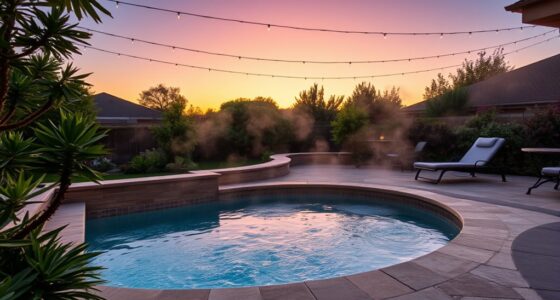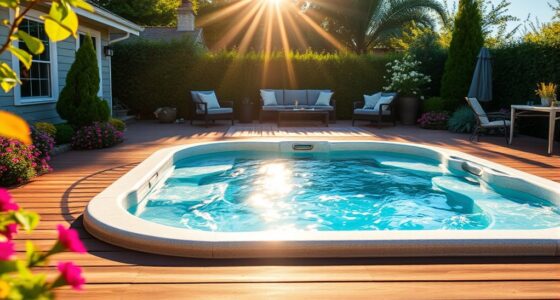For training, aim for water temperatures between 78 and 82°F (25-28°C) to prevent overheating and allow longer, safer workouts. In therapy, water is typically warmer, ranging from 90 to 104°F (32-40°C), to promote relaxation and healing. Maintaining the right temperature enhances safety and effectiveness in both settings. If you want to discover more about how each targets specific outcomes, keep exploring the details.
Key Takeaways
- Therapeutic water is typically maintained between 90-104°F (32-40°C) to promote relaxation and healing.
- Training water is kept cooler, around 78-82°F (25-28°C), to prevent overheating during exercise.
- Higher temperatures in therapy enhance blood flow and pain relief, while cooler water in training supports endurance and safety.
- Proper temperature control minimizes risks such as burns in therapy and heat exhaustion in training.
- Understanding these differences optimizes safety, comfort, and effectiveness in aquatic environments.

Have you ever wondered how water temperature affects aquatic life and water quality? When it comes to water used in training and therapy, temperature plays a crucial role. For training purposes, athletes often prefer slightly cooler water to help regulate body temperature and reduce overheating during intense workouts. On the other hand, therapy sessions typically utilize warmer water, which enhances hydrotherapy benefits like muscle relaxation, pain relief, and improved circulation. Understanding these distinctions is key to optimizing each environment for safety and effectiveness.
In therapeutic settings, maintaining the right water temperature is vital for maximizing hydrotherapy benefits. Warm water, usually between 90 to 104°F (32 to 40°C), helps relax muscles, soothe joint pain, and promote blood flow. This temperature range encourages relaxation and healing, making it easier for therapists to target specific conditions. However, water safety remains a top priority—if the water gets too hot, it can cause burns or overheating, especially in vulnerable populations like seniors or people with circulatory issues. Conversely, water that’s too cold can lead to shock or discomfort, potentially counteracting the therapy’s benefits. Proper monitoring and control of water temperature ensure that clients experience the intended therapeutic effects without risking adverse reactions.
When it comes to training, cooler water temperatures—around 78 to 82°F (25 to 28°C)—are often preferred. Cooler water helps prevent overheating and allows athletes to sustain longer training sessions without fatigue. It also enhances water safety by reducing the risk of heat-related illnesses, which can be especially dangerous during high-intensity workouts. However, if the water is too cold, it could cause muscle stiffness or cramping, which may impair performance or increase injury risk. That’s why setting the right temperature is crucial: it balances comfort, safety, and performance. In both training and therapy, consistent temperature control minimizes risks, ensuring participants can focus on their activities without distraction or concern.
Ultimately, understanding water temperature targets helps you create safe, effective environments. Whether you’re designing a therapy pool or setting up a training session, paying close attention to water safety and the desired hydrotherapy benefits ensures optimal results. Adjusting temperatures appropriately helps prevent accidents, enhances comfort, and boosts the overall experience. Keep in mind that individual needs vary, so always tailor water temperature to the specific goals—whether for healing or performance—while maintaining rigorous safety standards. This way, you can harness the full potential of water as a tool for health and fitness.
Frequently Asked Questions
How Do Water Temperature Preferences Vary Between Individuals?
You notice that water temperature preferences vary because personal comfort and temperature regulation differ from person to person. Some individuals prefer warmer water to relax muscles, while others favor cooler water for invigorating effects. Your body’s natural ability to regulate temperature influences what feels comfortable, so it’s important to listen to your own cues. Adjusting water temperature to suit your needs helps you maximize benefits and stay comfortable during training or therapy sessions.
What Are the Long-Term Effects of Different Water Temperatures?
You might notice that long-term exposure to different water temperatures influences your thermal regulation and temperature adaptation. Warm water can relax muscles and improve circulation, while cold water boosts alertness and reduces inflammation. Over time, your body adjusts to these stimuli, enhancing resilience and recovery. This natural adaptation supports overall health by strengthening your body’s ability to regulate temperature, making you more comfortable and resilient in varied environments.
How Does Water Temperature Influence Muscle Recovery Speed?
You’ll notice that warmer water speeds up muscle recovery by promoting muscle relaxation and enhancing circulation. This improved blood flow delivers more oxygen and nutrients to tired muscles, helping them recover faster. Conversely, cooler water slows down circulation, reducing inflammation and soreness. By choosing the right water temperature, you can optimize your recovery process, ensuring your muscles relax and heal efficiently after intense activity.
Are There Safety Concerns With Extreme Water Temperatures?
Sure, jumping into boiling water sounds fun, but safety’s no joke. Extreme water temperatures can cause thermal discomfort and skin damage, risking burns or hypothermia. You might think you’re tough, but ignoring these risks can lead to serious harm. Always check water temps carefully, avoid extremes, and listen to your body’s signals. After all, pushing limits is fine—just don’t forget you have one, and safety should always come first.
How Should Water Temperature Be Adjusted for Different Age Groups?
You should make age-specific adjustments to water temperature based on the individual’s needs and safety. For children, keep water warmer, around 92-96°F, to prevent chills, while older adults benefit from slightly cooler temperatures, around 89-92°F, to avoid overheating. Follow temperature guidelines carefully and monitor responses, ensuring comfort and safety. Always consult healthcare professionals for personalized recommendations, especially for vulnerable populations.
Conclusion
Think of water temperature as the compass guiding your journey—whether you’re training or in therapy. For ideal results, stay on course with the right temperature, like a trusted map leading you to your destination. Training heats things up for strength and endurance, while therapy provides a gentle, calming stream for healing. By choosing the right water temperature, you set yourself up for success—navigating your wellness journey smoothly, like a boat gliding effortlessly down a peaceful river.









